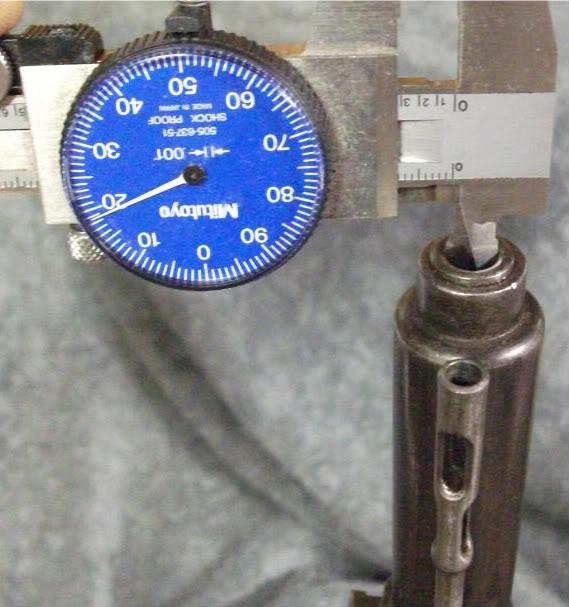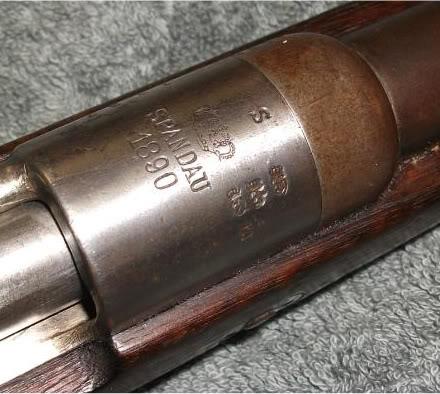-
PS: Paul Scarlatta wrote a great book on the Gew88 I can wholeheartedly recommend. One thing I will say though, is take his section on Gew88 bore dimensions with a grain of salt. According to him, .321-.323" barrels were not installed until 1896 and earlier barrels were sometimes re-bored to this dimension from .318" and marked with a "Z".
In my experience, this is generally false. I have slugged a good many 88 bores that were NOT Z marked and were pre-1896 (my above 1890 Steyr is an example). I have yet to see a gun with a .318" bore with a German -made barrel on it. The only .318's I've seen had Ecuadorian-installed Czech
-made barrel on it. The only .318's I've seen had Ecuadorian-installed Czech inter-war barrels on them.
inter-war barrels on them.
YMMV.
Союз нерушимый республик свободных Сплотила навеки Великая Русь. Да здравствует созданный волей народов Единый, могучий Советский Союз!
-
Thank You to Claven2 For This Useful Post:
-
05-13-2013 08:09 PM
# ADS
Friends and Sponsors

-
Legacy Member


Originally Posted by
Claven2

................................
The S mark also denoted that an S patronen reamer had been used in the chamber to ensure the 1905 round would work ok. On most rifles this would not have even cut metal, it was a safety precaution to ensure the neck diameter was sufficient.
The Germans shot M88 and M1905 ammo in these guns interchangeably when they had them in service, with the S round preferred for guns so converted because the rear sight leaf had been re-regulated accordingly. At short range, it didn't really change performance switching to M88 ammo, which the Germans were keen to use up as conversion of rifles to S pattern progressed.
Most GERMAN barelled 88's will have a bore diameter between .321 and .323, totally safe to fire the .323 military ammo OF THAT DAY.
Where it get dicey is that in 1934, the 8x57JS was beefed up considerably to a 198gn boat tailed spitzer with a heavier recoil impulse for use in the
K98k
and machine guns. I would NOT fire the M34 loading of 8x57JS in my Gew88, and neither did turkey who stuck with the M1905 version of the 8x57.
As stated before, SLUG YOUR BARREL before shooting standard 154gn 8x57 in your Gew88 rifle. Chances are you have the .323" bore, but you want to make sure - trust me.
Absolutely correct, Claven2, thank you for stating it clearly and correctly.
The ones you do have to watch out for are those imported from Ecuador by Gibbs in the relatively recent past; many, but not all, have Czech -made barrels with small bores and are not safe with even WW1 standard "S" ammunition, even though many will have the German applied "S" stamp on the receiver. As suggested above, slug your bore to be sure.
-made barrels with small bores and are not safe with even WW1 standard "S" ammunition, even though many will have the German applied "S" stamp on the receiver. As suggested above, slug your bore to be sure.
-
Thank You to gew8805 For This Useful Post:
-
Legacy Member

"even though many will have the German applied stamp", very good point. Good facts here. That stamp was applied circa 1904(??) and these Ecuadorian rifles were re-barreled in a huge project post-WWI. I can guess 1925-29 timeframe. So the stamp and reality are at odds as these are not true "S" rifles. The Czech
applied stamp", very good point. Good facts here. That stamp was applied circa 1904(??) and these Ecuadorian rifles were re-barreled in a huge project post-WWI. I can guess 1925-29 timeframe. So the stamp and reality are at odds as these are not true "S" rifles. The Czech barrels were held to the 1888 specs and are very tight .318 bores. You will find these barrels in near mint condition and the reasonable impulse is to shoot them. Look for a Circle Z stamp on the barrel, not on the jacket, but on the barrel. Be alert. Good luck to all.
barrels were held to the 1888 specs and are very tight .318 bores. You will find these barrels in near mint condition and the reasonable impulse is to shoot them. Look for a Circle Z stamp on the barrel, not on the jacket, but on the barrel. Be alert. Good luck to all.
-
Thank You to Calif-Steve For This Useful Post:
-
If you just want to do a quick check, and either have a calibrated tool or a known 0.323" bored Mauser handy, then you could try this method:

1888 with "S" marked receiver ring.

Not super scientific if you want to split thousandths, but...
-
-
Bear in mind that a vernier calliper thusly used will under-report bore diameter by about 3 thou due to the bore inner curvature and the width of the calliper flats. If the shown bore were slugged, I'd bet the slug would measure out at .321".
Союз нерушимый республик свободных Сплотила навеки Великая Русь. Да здравствует созданный волей народов Единый, могучий Советский Союз!
-
Thank You to Claven2 For This Useful Post:
-
Legacy Member

Great information , gentlemen. Out of curiosity, are the Ecuadorian rifles clearly marked with large crests, etc. My own 88/05 is a former Turk with replacement Czech bolt and in very good
bolt and in very good
condition. Best deal I've had in a while- $275.00.
Ridolpho
-
-
FREE MEMBER
NO Posting or PM's Allowed

Rido,
The answer is NO.. they are not clearly marked as such (with Crests). Generally they are not modified in an 1888/ 05 or 1888/15 type of configuration. If you pull off the shroud, then you will see the Z. If I get a chance and can dig up one of my barreled receivers, I will post a photo of the barrel.
-

Originally Posted by
Claven2

Bear in mind that a vernier calliper thusly used will under-report bore diameter by about 3 thou due to the bore inner curvature and the width of the calliper flats. If the shown bore were slugged, I'd bet the slug would measure out at .321".
Hmmm, these are the only calipers with which I do small IDs (at home), but usually they've been very close. The ID jaws are very narrow on this set. Will investigate further.
-
-
Did a quick test with a calibrated digital caliper set against a 0.3127" ring gage. The calipers read 0.310(5)", so in this case about 0.002" small. Now I'm curious: wondering if small hole gages could be used, perhaps with some narrowing. Also, at what point the error for the ID jaws becomes negligible i.e. 0.0005" or less. Too lazy (and busy) to do the math right now...
 But I did give myself an out in the other post by noting that a comparative check against a known 0.323" bore could be done. It's only the variance that matters.
But I did give myself an out in the other post by noting that a comparative check against a known 0.323" bore could be done. It's only the variance that matters.
-
Thank You to jmoore For This Useful Post:
-
I knew what you meant, was just ensuring ppl don't wrongly assume a direct .318 vernier measurement of bore equates to a .318 bore. You have to slug to get a precise reading.
-
The Following 2 Members Say Thank You to Claven2 For This Useful Post:
-made barrel on it. The only .318's I've seen had Ecuadorian-installed Czech
inter-war barrels on them.

















 PM
PM








 But I did give myself an out in the other post by noting that a comparative check against a known 0.323" bore could be done. It's only the variance that matters.
But I did give myself an out in the other post by noting that a comparative check against a known 0.323" bore could be done. It's only the variance that matters.

